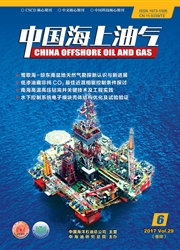

 中文摘要:
中文摘要:
以南海某半潜式钻井平台为例,通过建立平台简化模型及气体扩散模型,模拟了南海环境下井喷天然气扩散行为,分析了可燃气云分布及发展规律。结果表明,风速5 m/s环境下产能200万m^3/d气井井喷天然气在短时间内形成稳定的大范围可燃气云,垂直方向上扩散至井架中部区域,来风作用下钻台下风向区域处于危险状态。风速较小时,可燃气云主要向上部空间发展,发生燃爆后将直接造成井架顶部设备失效;随着风速增大,可燃气云达到稳定状态时间缩短,稳定状态下其空间分布范围减小,向下风向的偏斜角度增大,发生燃烧易导致井架坍塌而引发连锁破坏。由于建筑物阻挡作用,船首和右舷来风强度减弱,气流不稳定,可燃气云达到稳定状态所用时间长,稳定状态下其分布范围最大;船尾来风时,可燃气云主要分布在生活区,燃爆产生的超压、高温和强热辐射会对生活区设备和人员产生较大伤害;左舷来风时,天然气随来风迅速飘离平台,可燃气云分布范围最小,右舷固井泵室、应急发电机室和振动筛房等易受到气云燃爆风险的危害。这些研究结论可以为我国南海深水油气钻采作业应急救援提供科学指导,对深水钻井平台防火灾、爆炸具有一定的参考价值。
 英文摘要:
英文摘要:
Taking the semi-submersible drilling platform in South China Sea as example, the simplified semi-sub- mersible drilling platform model and gas diffusion model have been constructed to simulate the gas diffusion behav- iors and analyze the gas cloud distribution characteristics and developing rules when blowout under the sea condi- tion. The results show that the gas blown out from a gas well with capacity of 2 million m^3 per day will form large and stable combustible gas cloud in short time at the wind velocity of 5 m/s, the cloud spreads to derrick middle area along the vertical direction, and the leeward area of drilling floor is dangerous under the effects of the wind. When the wind slows down, the combustible cloud spreads upwards mainly and destroys the equipment topside of derrick when combustible cloud is ignited. Along with the wind velocity increasing, the time needed to form stable combustible gas cloud decreases, the spatial scope of combustible cloud becomes smaller under steady stage and the combustible cloud declines downwind. The gas burning can cause derrick collapse and lead knock-on destroys. The bow wind and starboard wind become weak and air become unstable due to the influence of buildings. The combus- tible gas will therefore take more time to spread to be stable and spatial scope of combustible cloud will become lar- ger. When stern wind, hazardous area mainly distributes in the accommodation area; persons and equipments will be damaged by overpressure and high temperature when ignited. When larboard side wind, natural gas can be easi- ly blown away from the platform and spatial scope of combustible cloud will become smaller. In the case, starboard cement room, emergency generator room and shale shaker house are vulnerable to the danger of gas cloud explo- sion risk. The results provide deep-water productive operation emergency rescue in our country with theoretical guidance and it is meaningful to prevent the platform from fire and explosion.
 同期刊论文项目
同期刊论文项目
 同项目期刊论文
同项目期刊论文
 期刊信息
期刊信息
